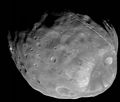Barkas:Phobos colour 2008.jpg

Gedhéning pratuduh iki: 636 × 600 piksel Résolusi liya: 255 × 240 piksel | 509 × 480 piksel | 815 × 768 piksel | 1.086 × 1.024 piksel | 2.172 × 2.048 piksel | 3.500 × 3.300 piksel.
Resolusi biasa (3.500 × 3.300 piksel, ukuran berkas: 2,72 MB, tipe MIME: image/jpeg)
Sajarah kaca
Klik nang tanggal/wektu kanggo ndeleng berkas kiye nang wektu kuwe mau.
| Tanggal/Wektu | Miniatur (''thumbnail'') | Ukuran | Panganggo | Komentar | |
|---|---|---|---|---|---|
| siki | 2 April 2018 03.10 |  | 3.500 × 3.300 (2,72 MB) | Kaldari | more margin on right side |
| 13 November 2008 04.47 |  | 3.374 × 3.300 (2,7 MB) | Fir0002 | == Summary == {{Information |Description=Colour image of Phobos, imaged by the Mars Reconnaisance Orbiter in 2008 |Source=NASA |Date=9 April 2008 |Location=http://www.nasa.gov/mission_pages/MRO/multimedia/pia10368.html |Author=NASA/J |
Pranala berkas
Ora ana kaca sing nyambung maring berkas kiye.
Panggunané barkas sajagat
Wiki liya ngisor iki nganggo barkas iki:
- Kanggo ing af.wikipedia.org
- Kanggo ing an.wikipedia.org
- Kanggo ing ar.wikipedia.org
- المريخ
- فوبوس
- قمرا المريخ
- ويكيبيديا:صور مختارة/الفضاء والكون/نظرة إلى الأعلى
- قائمة أجرام المجموعة الشمسية مرتبة حسب الحجم
- بوابة:علم الفلك/صورة مختارة
- بوابة:المريخ/مقالة مختارة/أرشيف
- بوابة:المريخ/مقالة مختارة/2
- قائمة الأقمار الطبيعية
- خط زمني لاكتشاف كواكب المجموعة الشمسية وأقمارها
- ويكيبيديا:ترشيحات الصور المختارة/القمر فوبوس
- ويكيبيديا:صورة اليوم المختارة/أغسطس 2019
- قالب:صورة اليوم المختارة/2019-08-03
- بوابة:علم الفلك/صورة مختارة/73
- معسكر قاعدة المريخ
- ويكيبيديا:صورة اليوم المختارة/يناير 2022
- قالب:صورة اليوم المختارة/2022-01-04
- Kanggo ing ary.wikipedia.org
- Kanggo ing arz.wikipedia.org
- Kanggo ing as.wikipedia.org
- Kanggo ing azb.wikipedia.org
- Kanggo ing az.wikipedia.org
- Kanggo ing be-tarask.wikipedia.org
- Kanggo ing be.wikipedia.org
- Kanggo ing bg.wikipedia.org
- Kanggo ing bh.wikipedia.org
- Kanggo ing bn.wikipedia.org
- Kanggo ing bn.wikibooks.org
- Kanggo ing bs.wikipedia.org
Deleng naraguna liyané sadonya saka kaca iki.




